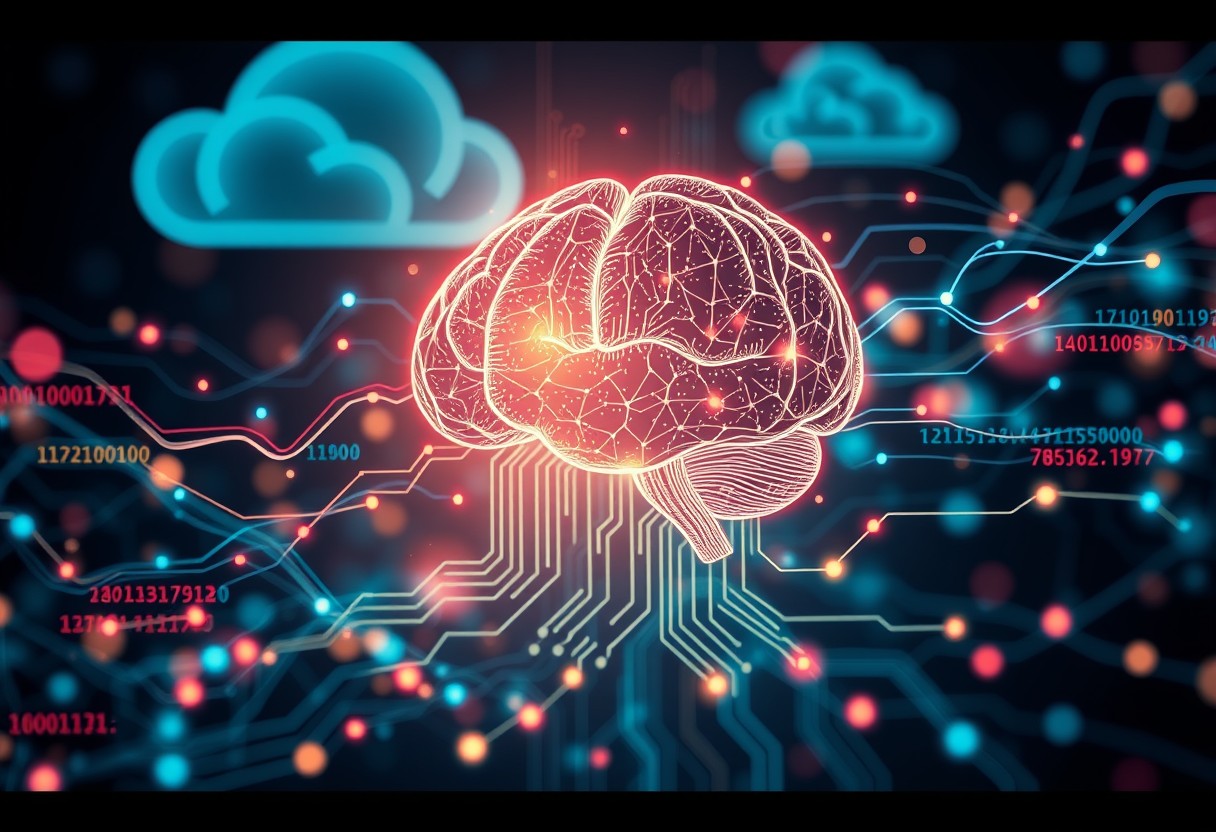
Just as organizations strive to harness the power of big data, I find that the integration of artificial intelligence (AI) into this realm offers groundbreaking opportunities and challenges. You may wonder how AI transforms raw data into actionable insights while optimizing cloud computing solutions for efficiency and scalability. In this blog post, I will research into the significant impacts of AI on data processing, privacy concerns, and the overall evolution of cloud technologies, helping you navigate this complex landscape with greater understanding and authority.
Understanding Artificial Intelligence
Your journey into artificial intelligence (AI) begins with a fundamental grasp of what AI truly means. In the contemporary landscape of technology, AI envelops a diverse range of processes designed to simulate human-like intelligence. This capability allows systems to perform tasks that typically require human intelligence, such as learning, reasoning, problem-solving, and understanding language. As your understanding of AI deepens, you will recognize its vast potential to revolutionize various industries, including big data and cloud computing.
Definition of Artificial Intelligence
Definition of artificial intelligence is a complex yet fascinating endeavor. AI primarily refers to the development of algorithms and computer systems that can execute tasks that, if humans were executing them, would necessitate cognitive functions. This field aims to create machines that can think and learn autonomously, drawing from data inputs and experience to inform their decisions. AI is no longer a theoretical concept but a practical technology with real-world applications that are evolving every day.
Understanding AI goes beyond merely defining it; it’s about entering into its implications and the ethical considerations it invites. Today, systems powered by AI are being utilized in diverse sectors from healthcare to finance, with potential far-reaching impacts on efficiency and productivity. Grasping these nuances equips you to appreciate the excitement and challenges of this technological wave.
Types of Artificial Intelligence
Any discussion of AI would be incomplete without elucidating the various types of AI systems that prevail today. These systems can generally be classified into two categories: Narrow AI and General AI. Narrow AI, also known as weak AI, focuses on performing specific tasks, such as facial recognition or language translation. Conversely, General AI, or strong AI, signifies a form of intelligence that transcends specific functions, aspiring to replicate human cognitive capabilities fully.
| Narrow AI | Designed for specific tasks |
| General AI | Replicates human cognitive functions |
| Reactive Machines | Basic forms; react to current situations |
| Limited Memory | Learn from past experiences |
| Theory of Mind | Future AI that understands emotions |
Importantly, understanding the types of AI enables you to better grasp how they are integrated within big data and cloud computing solutions. Within the spectrum of AI, the potential for continuous learning and adaptation underlines the difference between the various classes of systems. For instance, while narrow AI excels in specialized functions, the promise of general AI lies in its ability to evolve and tackle more intricate challenges across multiple domains. This distinction is vital for leveraging AI in broad-reaching applications.
Machine Learning vs. Deep Learning
An important distinction within AI is between Machine Learning and Deep Learning. Machine Learning refers to the extraction of insights from data through algorithms that identify patterns and make predictions. It leverages data-driven methodologies to improve the accuracy of outcomes over time. Deep Learning, a subset of Machine Learning, utilizes neural networks inspired by the human brain’s structure to analyze vast amounts of data and learn intricate patterns in a more sophisticated manner.
Delving deeper, it is crucial to realize that while all deep learning is machine learning, not all machine learning is deep learning. Machine learning can employ simpler techniques and smaller datasets, whereas deep learning requires extensive datasets and significant computational power. This differentiation is critical, especially as you consider how each applies to big data analytics and AI solutions geared toward cloud computing.
Natural Language Processing
Artificial intelligence has advanced significantly in Natural Language Processing (NLP), a field focusing on the interaction between computers and humans through natural language. In practice, this involves enabling machines to understand, interpret, and generate human language, allowing for more seamless communication between humans and technology. As I explore NLP applications, I’m continually astounded by how AI can facilitate tasks such as sentiment analysis, translation, and automated customer service.
Artificial intelligence’s capacity for Natural Language Processing plays a critical role in bridging the gap between structured data and human interaction. With robust algorithms, NLP tools can analyze vast amounts of text reactions and sentiments in real-time, delivering valuable insights and improving user experience. As we traverse this digital landscape, understanding the advantages of NLP enhances your ability to advocate for effective solutions that leverage these technologies. This understanding of NLP as part of AI demonstrates its potential to transform how companies communicate and operate.
Overview of Big Data
Little did we know that the exponential growth of data would revolutionize how we conduct business and analyze our world. As we probe into Big Data, it’s vital to understand what this term truly encompasses and why it has garnered so much attention in recent years.
Definition of Big Data
Data is often described as the lifeblood of modern technology, but when we talk about Big Data, we refer to the massive volumes of data that cannot be processed using traditional methods. This data comes in various forms, including structured, semi-structured, and unstructured, and is generated every second from numerous sources such as social media, IoT devices, transactions, and sensors. With such a diversity of data, the challenge lies not just in gathering it but also in extracting meaningful insights that can drive decision-making.
Characteristics of Big Data (The 5 Vs)
With the emergence of Big Data, we often refer to the characteristics that define it as the 5 Vs: Volume, Velocity, Variety, Veracity, and Value. Each of these dimensions highlights a different challenge and opportunity associated with processing large datasets. The sheer volume of data generated is staggering, requiring virtually limitless storage solutions; it arrives at a velocity that demands real-time processing; it exists in variety, coming from numerous sources and in different formats; the veracity of data must be assessed to ensure accuracy and reliability; and lastly, there is value that can be extracted only if the data is analyzed effectively.
Definition of the 5 Vs is crucial because understanding these characteristics allows organizations to implement better data strategies. For instance, businesses that appreciate the velocity of data can employ real-time analytics to swiftly adapt to market changes. Furthermore, embracing the variety of data means that organizations can leverage different data types, from social media engagement to transactional data, ensuring a holistic view of their operations.
Importance of Big Data in Today’s World
The importance of Big Data in today’s world cannot be overstated. Organizations across industries are leveraging it to gain a competitive edge, optimize operations, and enhance customer experiences. For example, in healthcare, practitioners use data analytics to predict patient outcomes and personalize treatments. In retail, businesses analyze purchasing patterns to tailor marketing strategies and improve inventory management. The ability to make data-driven decisions enables organizations to respond proactively to shifts in consumer behavior and market landscapes.
Moreover, I find that those who embrace Big Data can uncover trends that were previously hidden, allowing them to innovate and improve their service offerings. Companies that utilize analytics effectively can gain insights into customer preferences and behaviors, leading to enhanced customer satisfaction and loyalty.
Challenges in Managing Big Data
World-class organizations face numerous challenges in managing Big Data effectively. The complexity of handling vast and varied datasets often leads to difficulties in integration, analysis, and security. As data volumes soar, traditional data management systems struggle to keep up, creating bottlenecks in processing speeds. Additionally, ensuring the security and privacy of sensitive information becomes increasingly daunting, especially when dealing with unstructured data from multiple sources.
Another significant challenge in managing Big Data is the need for skilled personnel who can analyze and interpret this information. Without the right expertise, organizations risk missing critical insights that could drive strategic initiatives. A robust data strategy is paramount to navigate these challenges and seize the opportunities that come with Big Data.
Cloud Computing Fundamentals
Despite the rapidly evolving digital landscape, cloud computing has emerged as a fundamental pillar in technology, driving innovation across various sectors. This powerful enabler allows businesses to leverage vast resources and capabilities without investing heavily in physical infrastructure. Understanding the core concepts of cloud computing is vital for organizations aiming to tap into its potential.
Definition of Cloud Computing
The term cloud computing refers to the delivery of computing services—such as servers, storage, databases, networking, software, analytics, and intelligence—over the Internet (“the cloud”). This model offers flexible resources, faster innovation, and economies of scale. Instead of owning their infrastructure or data centers, organizations can access these services on an as-needed basis, thereby optimizing costs and resources.
By facilitating on-demand availability of computer resources via the Internet, cloud computing has fundamentally changed the way we approach technology, promoting a scalable and efficient resource management model. The opportunity to pay only for what you use allows businesses of all sizes to remain agile and competitive.
Types of Cloud Services: IaaS, PaaS, and SaaS
PaaS, IaaS, and SaaS are the three primary cloud service models that offer distinct advantages depending on the needs of your organization. Each model serves to enhance productivity and streamline operations—making the selection of the appropriate service crucial. Here’s a brief overview:
| IaaS | This service provides basic computing infrastructure (servers, storage) on demand. It’s flexible and suitable for developers needing to deploy managed virtual machines. |
| PaaS | Platform as a Service allows developers to build, test, and deploy applications without worrying about managing underlying hardware and software. |
| SaaS | Software as a Service delivers software applications over the Internet on a subscription basis, making it accessible from anywhere. |
| Scalability | All models provide the flexibility to scale up or down based on your current needs, ensuring you only pay for what you use. |
| Accessibility | These services can be accessed from various devices, enabling workforce mobility and collaboration. |
With each service model offering unique features, the choice largely depends on specific business needs. By understanding the differences between IaaS, PaaS, and SaaS, you can make informed decisions about which services align with your strategic goals. Thou it’s important to recognize that leveraging these services brings significant operational and financial advantages.
- Flexibility: Adapting resources based on demand.
- Cost Savings: Reducing capital investment in hardware and facilities.
- Collaboration: Enhancing teamwork through accessible tools.
- Data Management: Improving data reliability and scalability.
- Innovation: Accelerating development of new services and products.
Benefits of Cloud Computing
Cloud computing brings a wealth of benefits that can empower organizations to reach new heights. Cloud solutions promote cost efficiency, optimizing your IT spending and eliminating unnecessary overheads associated with traditional infrastructure. The capability to scale resources on demand enhances agility, thereby allowing your business to respond swiftly to market changes.
Additionally, cloud computing fosters collaboration among teams by enabling real-time data access and sharing across multiple locations. This connectivity aids in breaking down silos and promoting a culture of collaboration, ultimately driving productivity.
IaaS platforms elevate operational capabilities by offering powerful computing resources that can be tailored to specific organizational needs. The protection and augmentation of data are paramount, and cloud services regularly integrate advanced security features to safeguard sensitive information.
Security Considerations in Cloud Computing
Cloud security is a crucial aspect to consider when migrating to cloud environments. While cloud providers implement various security measures, organizations must remain vigilant regarding data privacy and compliance issues. I recommend performing thorough due diligence when evaluating potential cloud service providers to ensure they align with industry regulations.
Furthermore, you should institute robust governance policies, ensuring that your data management practices adhere to established standards. Understanding that cloud solutions, while secure, are not infallible can help you better prepare for potential risks.
Services in the cloud can be highly effective, yet the responsibility for maintaining security cannot be offloaded entirely to third-party vendors. It is vital to actively manage and monitor your cloud environment to mitigate risks effectively. Keep in mind that shared responsibility models dictate that both the provider and the client have roles in safeguarding the data stored within the cloud.
Integration of AI in Big Data Solutions
Unlike traditional data processing methods, the integration of artificial intelligence (AI) in big data solutions has transformed the way we analyze and interpret vast amounts of information. This synergy not only enhances efficiency but also adds layers of sophistication to the data analytics process. One area where I see significant benefits is in data analytics and predictive modeling, where algorithms can sift through extensive datasets, identifying patterns and trends that would otherwise remain hidden. By leveraging AI’s capabilities, organizations can make more informed decisions based on predictive insights that allow for proactive rather than reactive responses to market changes.
Data Analytics and Predictive Modeling
Integration of AI into data analytics empowers businesses to conduct predictive modeling with greater accuracy and speed. AI-driven tools enable the analysis of historical data to forecast future outcomes, revealing customer behaviors, market trends, and potential risks. With these insights, you can fine-tune your strategies and allocate resources more effectively, leading to improved performance across all levels of your organization.
Enhancing Data Quality with AI
Solutions for enhancing data quality have become increasingly sophisticated with the incorporation of AI technologies. By using machine learning algorithms, organizations can now automatically detect anomalies, inconsistencies, and inaccuracies in large datasets. This not only improves the overall integrity of the data but also frees up valuable time that your team can invest in more strategic initiatives, rather than getting bogged down by manual data cleaning.
Another crucial aspect of enhancing data quality with AI involves the continuous learning capabilities of machine learning models. These models adapt and improve over time, refining their ability to detect errors and ensure data accuracy as new data becomes available. This iterative process ensures that your organization is always working with the most reliable data possible, which is vital for sound decision-making.
Real-Time Data Processing and AI
Processing data in real-time has become a prerequisite for organizations aiming for a competitive edge. With the integration of AI technologies, businesses can analyze streaming data instantly, transforming raw information into actionable insights at breakneck speed. I find this especially crucial for industries like finance or e-commerce, where timely insights can mean the difference between seizing an opportunity or losing it.
With real-time data processing, organizations can respond to changing conditions and customer behaviors almost instantaneously. This agility allows for more personalized marketing strategies and immediate adjustments to operational processes, ensuring you remain attuned to emerging trends and customer needs.
Automating Data Discovery and Management
With AI’s integration, automating data discovery and management processes has never been easier. AI-driven tools can systematically scan and catalog data across various silos, ensuring you have a comprehensive view of your information assets. This automation not only enhances operational efficiency but also minimizes the risk of missing critical data in decision-making processes.
For instance, these AI systems can classify and prioritize data based on its relevance to specific business objectives, allowing you to focus your analytics efforts where they matter most. By doing so, your organization can streamline its data management practices, ultimately leading to more effective use of resources and knowledge-driven strategies.
Synergy Between AI and Cloud Computing
Once again, I find myself exploring the profound relationship between two transformative technologies: Artificial Intelligence (AI) and Cloud Computing. When harnessed together, these technologies create an ecosystem that enhances functionality, improves performance, and drives innovation across various sectors. This synergy opens up new avenues for businesses seeking to leverage data and computational power in the most efficient way possible. By understanding this relationship, you can better appreciate how your organization can benefit from integrating AI within a cloud framework.
AI-Driven Cloud Services
With the emergence of AI-driven cloud services, organizations now have access to advanced capabilities that were previously unattainable. These services, powered by machine learning and intelligent algorithms, allow you to automate processes, analyze vast datasets, and derive insights that inform strategic decision-making. This means that instead of spending time on mundane tasks, you can focus on innovation and growth, making your business not just more efficient but also more competitive.
Moreover, AI-powered cloud solutions can adapt to your specific needs, offering customization options that make it easier for your business to thrive in a fast-paced environment. Whether you are looking for predictive analytics or real-time monitoring, AI-driven cloud services can streamline these processes, providing a robust platform that scales as your needs evolve. The potential for integrating AI into cloud-based infrastructures is vast, enabling your organization to remain agile and proactive in today’s digital landscape.
Scalability and Flexibility in AI Solutions
Scalability is crucial when it comes to implementing AI solutions within a cloud framework. With the rapid changes and expanding data volumes that businesses face, you need solutions that can scale seamlessly to meet your requirements. Cloud computing allows you to tap into virtually limitless resources, ensuring that your AI applications can grow without interference. This flexibility not only helps optimize performance but also ensures that your investment is protected as your needs shift.
In today’s dynamic marketplace, the ability to scale up or down based on real-time needs can be a game-changer. It gives you the power to innovate without being bogged down by limitations. This means you can take advantage of opportunities as they arise, whether through deploying new models, accommodating increased workloads, or testing hypotheses without significant financial risk. The fusion of scalability and flexibility fosters an environment that is conducive to experimentation and pioneering advancements.
To truly harness the benefits of AI and cloud computing, organizations must embrace the scalability and flexibility these technologies offer. This includes a shift in mindset, viewing technology as an enabler rather than a constraint. By doing so, you can transform your organization into one that is agile, capable of adapting to changes quickly, and ready to leverage new technologies as they become available.
Cost-Effectiveness of Cloud-Based AI
Any discussion about the advantages of cloud and AI integration must address cost-effectiveness. Cloud computing eliminates the need for upfront hardware investments, which can significantly reduce your operational costs. Instead, it operates on a pay-as-you-go model, allowing you to align your expenses directly with resource consumption. This flexibility means you are not paying for unused resources, making it easier to manage budgets while maximizing your AI capabilities.
Furthermore, when combined with AI, cloud solutions not only reduce costs associated with hardware but also enhance efficiencies and lower maintenance costs. These factors collectively contribute to a more sustainable financial model for your organization. Consider the long-term implications: as your AI capabilities grow, the cloud’s inherent cost-saving features can maintain your bottom line while you pursue ambitious AI-driven projects.
Understanding the cost-effectiveness of cloud-based AI solutions is vital for any organization looking to innovate. The financial flexibility it provides allows for longer-term planning and resource allocation, making advanced analytics and intelligent automation accessible without breaking the bank. This encourages you to invest in AI initiatives that can drive substantial returns on investment over time.
The Role of Edge Computing
With the advent of the Internet of Things (IoT) and the need for real-time data processing, edge computing has emerged as a crucial component of the AI-cloud synergy. By processing data closer to its source, edge computing reduces latency and enhances the responsiveness of AI applications. This means that you can achieve more immediate insights and take timely actions based on real-time data analysis. It streamlines operations and offers a layer of efficiency that is necessary for high-stakes decision-making environments.
As organizations increasingly rely on data from devices like sensors and cameras, deploying AI models at the edge allows you to leverage computational resources where they are most needed. The combination of cloud and edge computing facilitates a more balanced and distributed architecture, empowering devices to make decisions and process information in real-time, even in remote or resource-constrained environments.
Between the vast computing power offered by the cloud and the quick, localized processing provided by edge computing, organizations can create a comprehensive structure that promotes efficiency and innovation. This dual approach allows you to streamline your operations and gather insights faster than ever, ensuring that your organization stays at the forefront of technological advancements. Together, AI and edge computing represent a formidable frontier that must not be overlooked in your strategy.
Future Trends and Developments
Now, as we explore the future of artificial intelligence (AI) in conjunction with big data and cloud computing solutions, it’s clear that the landscape is set for a significant transformation. The convergence of these technologies paves the way for enhanced efficiency, improved decision-making, and the potential for innovative solutions that can tackle some of the world’s most pressing problems. I believe that staying ahead of these trends will be critical for businesses looking to remain competitive in an increasingly data-driven economy.
Emerging Technologies in AI, Big Data, and Cloud
Cloud computing is evolving rapidly, enabling organizations to harness vast amounts of data and apply advanced AI techniques for superior analytics. New technologies such as edge computing are helping to process data closer to its source, minimizing latency and enhancing real-time insights. As AI algorithms become more sophisticated, they can analyze complex datasets more efficiently, resulting in quicker and more accurate predictions. I envision that the synergy between cloud infrastructure and AI capabilities will unlock unprecedented opportunities for businesses to leverage their data in meaningful ways.
Additionally, the rise of quantum computing holds immense potential to revolutionize how we approach big data and AI. With its ability to perform complex computations at lightning speed, quantum technology could enhance machine learning processes, allowing for deeper insights from larger datasets. I am excited about the implications this could have for various industries, from healthcare to finance, where AI and big data are already making significant strides.
The Impact of IoT on Big Data and AI
Trends in the Internet of Things (IoT) are generating massive amounts of data that can be harnessed by AI analytics to enhance decision-making processes. With an increasing number of devices becoming connected, businesses are provided with real-time data that can yield valuable insights. I see this as a significant advantage, allowing companies to optimize their operations and engage more effectively with their customers. The integration of IoT with AI and big data analytics can lead to smarter product development and responsive supply chain management.
For instance, smart homes equipped with IoT devices generate continuous streams of data regarding user behavior, preferences, and environmental conditions. AI can analyze this data, leading to personalized services and energy-efficient solutions. As I reflect on this development, I am reminded of how integral this interconnectedness will become in shaping the future of various sectors and driving innovations that enhance user experiences.
Ethical Considerations and Regulatory Frameworks
Data privacy and ethical considerations are paramount as we advance in the realms of AI, big data, and cloud computing. I am continuously aware of the concerns over how personal information is obtained, stored, and utilized. As AI systems become more prominent, it is crucial to establish strong regulatory frameworks that protect individuals’ rights and promote data integrity. I believe that organizations should prioritize ethical AI practices to foster trust and accountability within their operations.
It is imperative for companies to not only comply with emerging regulations but to also adopt ethical principles that govern the usage of AI and data. As I observe the landscape, I notice a growing recognition of the need for transparency in AI algorithms and processes. There is a collective responsibility among stakeholders to create a framework that ensures equitable access and minimizes bias in AI outcomes, fostering a more inclusive approach to technology.
The Future of Work with AI and Cloud Technologies
Work is evolving alongside advancements in AI and cloud technologies, and I am intrigued by how these changes will redefine roles and responsibilities across industries. As AI takes over more repetitive and data-intensive tasks, professionals can redirect their focus towards strategic initiatives that require human creativity and emotional intelligence. I see this as a positive shift that allows workers to enhance their skills and pursue more engaging and impactful careers.
This transformation brings forth the concept of hybrid work environments where technology complements human effort, creating a more collaborative atmosphere. You will find that roles in data analysis, cloud management, and AI development will grow in demand, pushing professionals to adapt and innovate continuously. As I look ahead, I am optimistic about the opportunities these changes present, with the potential for a workforce that is more skilled, adaptable, and ready to face the challenges of tomorrow.
Final Words
With this in mind, I believe that the intersection of artificial intelligence, big data, and cloud computing is truly transformative for businesses and individuals alike. The capability of AI to analyze vast amounts of data swiftly and accurately means that organizations can uncover insights that were previously hidden. As you consider implementing these technologies in your own context, remember that leveraging AI can enhance data-driven decision-making and optimize operations significantly. It’s not just about managing large datasets anymore; it’s about harnessing the power of those datasets to drive innovation and efficiency.
Furthermore, as I reflect on the rapidly evolving landscape, it’s clear that cloud computing acts as a robust backbone for AI applications. It provides the scalability, flexibility, and accessibility that modern enterprises require to adapt to changing market conditions. For you, this means that embracing these tools can lead to enhanced business agility and competitive advantage. Whether you are a data scientist, an IT professional, or a business leader, integrating AI with big data and cloud solutions will undoubtedly enable you to navigate the complexities of today’s digital ecosystem more effectively.





